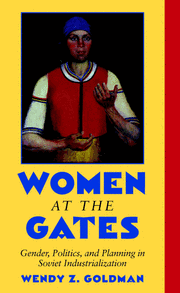Book contents
- Frontmatter
- Contents
- Acknowledgments
- List of Illustrations
- List of Tables
- Acronyms and Abbreviations
- Women at the Gates
- Introduction
- 1 Guarding the Gates to the Working Class: Women in Industry, 1917–1929
- 2 The Struggle over Working-Class Feminism
- 3 The Gates Come Tumbling Down
- 4 From Exclusion to Recruitment
- 5 “The Five-Year Plan for Women”: Planning Above, Counterplanning Below
- 6 Planning and Chaos: The Struggle for Control
- 7 Gender Relations in Industry: Voices from the Point of Production
- 8 Rebuilding the Gates to the Working Class
- Conclusion
- Index
- Plate Section
7 - Gender Relations in Industry: Voices from the Point of Production
Published online by Cambridge University Press: 30 July 2009
- Frontmatter
- Contents
- Acknowledgments
- List of Illustrations
- List of Tables
- Acronyms and Abbreviations
- Women at the Gates
- Introduction
- 1 Guarding the Gates to the Working Class: Women in Industry, 1917–1929
- 2 The Struggle over Working-Class Feminism
- 3 The Gates Come Tumbling Down
- 4 From Exclusion to Recruitment
- 5 “The Five-Year Plan for Women”: Planning Above, Counterplanning Below
- 6 Planning and Chaos: The Struggle for Control
- 7 Gender Relations in Industry: Voices from the Point of Production
- 8 Rebuilding the Gates to the Working Class
- Conclusion
- Index
- Plate Section
Summary
With babas, there is a lot of trouble. It is not worth it to put them to work at the bench.
Master of the mechanical shop in Lavshchutskii factoryWhen we raise the question of hiring women in transport, the union officials and managers refuse with every bone in their bodies and say, “We do not want women,” even though they have the same skills as men and are able to work. This shows that the old life still lives among us, that the exploitation of women by men still has not disappeared.
Vinogradova, female switchman on the Northern railroad line, working since age sixteenWomen workers and activists were well aware of the failure of local authorities to implement the plans generated in Moscow, but they did not attribute the failure to disorganization or inadequate statistics. To them, the single most important factor influencing women's opportunities in the workplace was male prejudice. The number of women hired, the jobs they received, their access to skilled work, and their treatment on the shop floor were all affected by male attitudes toward female labor. Women were fiercely critical of planners, union and labor-department officials, managers, local Party leaders, foremen, shop heads, brigade leaders, and even their male coworkers. In their view, these men shared powerful prejudices that shaped, and limited, the world of female labor.
Prejudice against female labor was not unique to Russia.
- Type
- Chapter
- Information
- Women at the GatesGender and Industry in Stalin's Russia, pp. 207 - 233Publisher: Cambridge University PressPrint publication year: 2002



